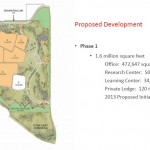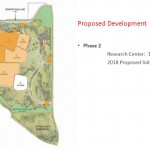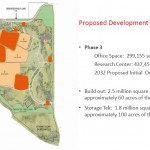Although final plans for ConocoPhillips’ research and training facility in Louisville have not even been submitted to the City, the project has already lifted housing prices in Louisville and is predicted to also buoy them in the cities of Boulder, Superior, and Lafayette, according to panelist Malcolm Fleming, Louisville City Manager, at a PLAN-Boulder forum on July 16. The 1.6 million square foot first phase of the project is expected to be finished in 2013, and the City of Louisville anticipates that the company will file its proposed final plan for the development this August or September. The preliminary plans already tendered by ConocoPhillips show 3,000 parking spaces, which the City guesses probably means around 3,000 employees will work in the complex. Malcolm noted that Louisville’s comprehensive plan allows for a total population of 23,000 people and that it already houses 20,000.
Malcolm disclosed that both Vestas and another, smaller wind turbine company have stated that proximity to ConocoPhillips’ facility was an important reason for their recent decisions to locate new operations in Louisville. Susan Osborne, mayor of the City of Boulder, remarked from the audience that the Conoco Phillips development has the potential to be a “game-changer” for Louisville, similar to the effect of IBM or NCAR on Boulder.
According to Troy Russ, Louisville’s Director of Planning and Building Safety and another member of the forum panel, phase one of the development is projected to add about 1,500 more vehicle trips on adjoining roads at the morning and afternoon peak times, which is less than were generated by the former Storage Tech plant at the site and would not require expanding the capacity of US 36. Troy said, though, that ConocoPhillips has promised to implement a Transportation Demand Management program to reduce vehicle trips to and from the campus by 30 percent, and that it has proposed adding two more access points to the current two, and building an extension to Campus drive, which should significantly reduce traffic on Dillon Road to Avista Hospital and Monarch High School.
The closest FasTraks and Bus Rapid Transit stops at Flatirons Crossing, McCaslin Boulevard, and downtown Louisville will all be more than a half mile from ConocoPhillips’ buildings, beyond reasonable walking distance. Some members of the audience advocated that ConocoPhillips be required to operate bus or van service to and from those stops.
The company has proposed two more phases of construction. Phase two will add 135,630 square feet of research space and be ready for initial occupancy in 2018, while phase three will include another 299,155 square feet of office space and 437,451 square feet of research space and be ready for initial occupancy in 2032.
Structures will occupy only 60 acres of the 432 acre site. In comparison, Storage Tech’s 1.8 million square feet of structures, which have now been completely razed, covered about 100 acres of the site. ConocoPhillip’s building heights will range from 35 feet to 95 feet, even though Louisville’s land use code has in the past only allowed maximum heights from 35 to 50 feet.
In an action which stirred controversy, Louisville, at ConocoPhillips’ request, this spring amended its municipal code to authorize its City Council to grant vested rights to developers even before a final plan has been reviewed or approved. The third panel member at the forum, Peter Stewart, a Louisville architect and historic preservationist, criticized the City for its willingness to approve irrevocably crucial aspects of a development, such as building height, before it had received complete information about them. He also commented that Louisville has been the place along US 36 where building heights fell and remained relatively low all the way to the Boulder mountain backdrop.
That effect will be spoiled by ConocoPhillips, he maintained.
Troy and Malcolm, however, defended the 95 foot height limit, contending that ConocoPhillips’ buildings would appear no higher than Avista Hospital does and would be lower than buildings to the south and east along US 36. They also claimed that the increased height of ConocoPhillips’ buildings would allow it to keep its campus relatively compact.
Troy clarified that no vested rights have been granted yet by Louisville and that none will be until ConocoPhillips has provided, and Louisville has approved, an architectural pattern book for the development. He claimed that the architectural pattern book will be both comprehensive and detailed. Various members of the audience encouraged Louisville to exercise great caution before permitting rights to vest.
ConocoPhillips’ preliminary plan provides for a compact, walkable campus with structured parking. It is designed to preserve the rural character of the property. Fifty-four acres of land will be dedicated to Louisville as open space, and the company has also proposed to give another 41.5 acres to Broomfield for open space. As a result, the property will appear to the public to be more open than before. Troy explained that ConocoPhillips has pledged to restore the vegetation on its “interior campus” to three different original prairie conditions, which for a while will require substantial irrigation using raw water. Peter observed, however, that ConocoPhillips’ open space dedications only meet the minimum currently required by Louisville.
The campus is supposed to be “closed,” meaning that employees will not need to leave to eat and meet other daily needs and that trainees will be lodged there. Malcolm ruefully observed that although that aspect of the plan will reduce vehicle miles, it will also greatly limit employee spending in downtown Louisville. He predicted that Flatirons Crossing in Broomfield will be the retail site that benefits the most from ConocoPhillips.
The company has vowed to add about $41 million in public amenities to the property, including the dedication of land as public open space, construction of public trials, landscaping and irrigations systems, burial of an Xcel power line, and construction of the extension of Campus Drive.
ConocoPhillips has estimated that its future property tax payments will yield $3.6 million a year to Boulder County and $6.1 million a year to the Boulder Valley School District. Malcolm claimed that at current cost levels that amount of tax revenue would pay for about 900 students to attend BVSD schools. He did not say, however, what amount of additional capital expenditure that number of students would require.
ConocoPhillips has also estimated that over 20 years its development will generate about $28 million in operating revenue for Louisville and cost Louisville an additional $13 million in operating expenses. Some members of the audience warned that the estimate of operating expenses was likely to be low, particularly for water use. ConocoPhillips has further estimated that Louisville will receive an additional $7.7 million in revenue for capital improvements and have to spend an additional $7.6 million for capital improvements, mostly on transportation. Malcolm asserted that the development’s permanent water demands can be accommodated by Louisville’s current inventory, although additional raw water would probably have to be obtained by the company at least for a few years to irrigate the restored prairie lands.






